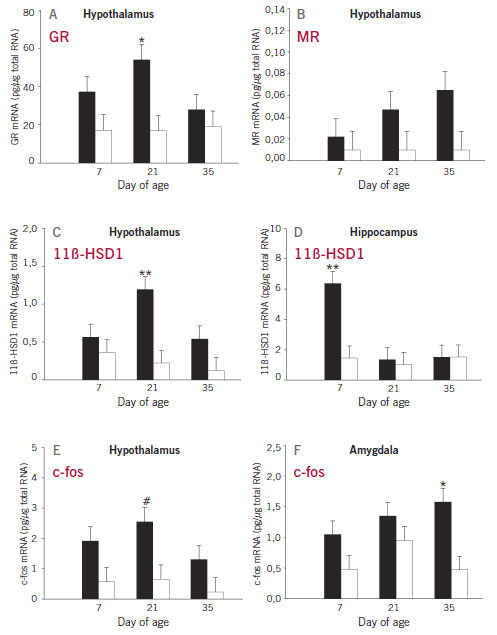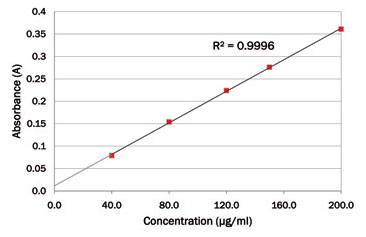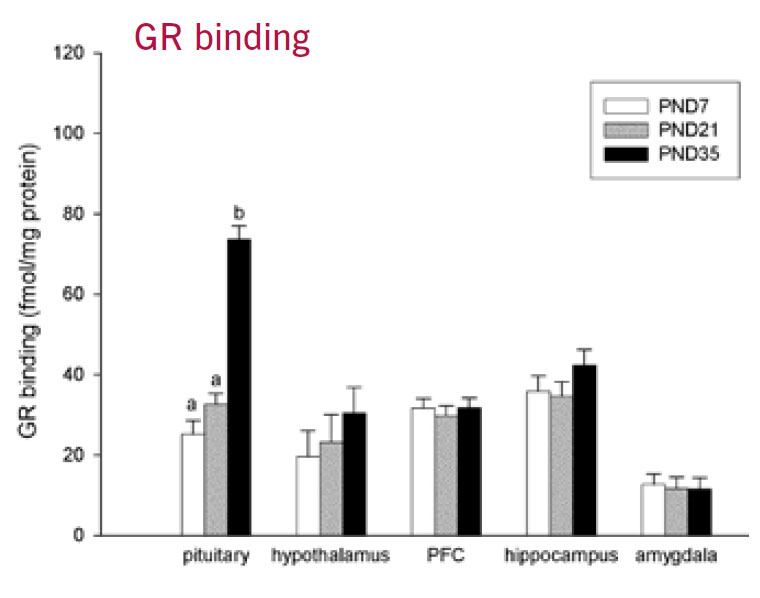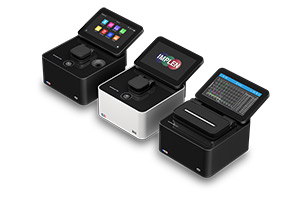NanoPhotometer®: Small Volume Spectrophotometric Applications in Veterinary Medicine
NanoPhotometer® Application Leaflets
Small Volume Spectrophotometric Applications in
VETERINARY MEDICINE
Social isolation in domestic pigs activates neuroendocrine stress response
Introduction:
There is a growing interest assessing psychosocial stress in farm animals to improve our understanding of animals’ welfare and health. In the past it was shown that psychosocial stress during early postnatal life, such as weaning and social isolation in pigs, activates the hypo-thalamic-pituitary-adrenal (HPA) axis, resulting in increased gluco-corticoid levels. Cortisol, the most important glucocorticoid in farm animals, plays a major role in maintaining homeostasis, regulates many physiological systems of the body and influences affective and cognitive function. The cellular responses to cortisol are mainly regulated by tissue specific receptor (glucocorticoid receptor, GR; mineralo- corticoid receptor, MR) distribution and receptor number, as well as presence and activation of glucocorticoid metabolizing enzymes (as the 11ß-hydroxysteroid dehydrogenase 1/2, 11ß-HSD1/2).
To study the molecular and functional modifications to psychosocial stress in pigs, analyses of mRNA expression and receptor binding studies of molecules that are involved in the central stress response, are required. For this project the multifunctional NanoPhotometer® from Implen, with its unique optical path, played two important roles. It was used for the quantification of the total RNA and for the determination of the protein concentration in tissue homogenate of different brain areas. Here the NanoPhotometer®, which is well-known for its high precision in small sample volume and standard cuvette applications, can be optimally used.
METHODS
mRNA extraction and quantification of transcripts
After a single 4 h isolation from the mother at different days of age (7, 21 and 35 days), RNA from distinct areas of the brain (hypothalamus, hippocampus and amygdala) was isolated with RNeasy Lipid Tissue Mini Kit (Qiagen). The total RNA concentration was quantified by the NanoPhotometer® measuring the absorbance at 260 nm in the cuvetteless small volume option (1.5 µl sample volume). The instrument enables an easy, fast and reliable analysis of the extracted RNA. The purity and integrity was assessed by the 260/280 nm ratio (protein impurity) and electrophoresis (2% agarose in TBE buffer) of the sample. Absolute quantification of mRNA using real-time reverse transcription polymerase chain reaction (RT-PCR) was performed as described by Löhrke et al. (2005) and Kanitz et al. (2009). The mRNA abundance was calculated using the known concentration of standard oligonucleotides and amplification efficiency displayed by the iCycler and expressed as pg per µg total RNA.
Glucocorticoid receptor (GR) binding
To characterize functional modifications in the development of the neuroendocrine stress system, GR binding was analysed in different brain areas of untreated piglet at 7, 21 and 35 days of age. The GR binding assay was performed as described in detail by Kanitz et al. (1998). The protein concentrations in all tissues were determined for each sample by the method of Lowry et al. (1951) with bovine serum albumin as standard. The colorimetric Lowry assay was performed with the pre-programmed Lowry method in the standard cuvette option of the Implen NanoPhotometer®. GR binding data were expressed as femtomole per mg of protein.
RESULTS:
mRNA expression in different brain areas
Maternal separation and/or social isolation (4 h) during early postnatal development in pigs caused an enhanced activation of the HPA axis accompanied by differential expression of GR, MR, 11ß-HSD1/2 and c-fos mRNA in the limbic system. It was possible to detect significant differences in the mRNA abundance between isolated and control piglets in these stress related brain region after 7, 21 and 35 days of age (Figure 1A-F). The neural activation seems to be associated with changes in the expression of GR, MR, 11ß-HSD1 and c-fos that may mediate both normal and pathological responses to subsequent stressors.
Protein quantification and GR binding in different brain areas
GR binding studies in stress-related brain regions of untreated piglets can be considered as measure of the natural, age dependent expression of the GR receptor during early life development. The determination of the protein concentration in different brain areas by the method of Lowry was routinely performed by using the Implen NanoPhotometer®. Figure 2 demonstrates the linearity of the protein quantification method (coefficient of determination R2 0.998) with the NanoPhotometer® under standard cuvette option.
From receptor binding studies in stress-related brain areas, the highest GR binding capacity was detected in the pituitary, PFC and hippocampus compared to the results in the hypothalamus and amygdala. Furthermore there was an age dependent increase in GR binding in the pituitary, but not in other stress-related brain regions (Figure 3).
The ontogenetic description of glucocorticoid receptors in neural development of postnatal pigs may provide an important contribution to development of species-specific understanding of adaptive and maladaptive functioning of the central stress system and should be involved in the evaluation of stressful life events in pigs.

Figure 1: Effect of social isolation on Glucocorticoid receptor (GR) (A), Mineralcorticoid receptor (MR) (B), 11ß-hydroxysteroid dehydrogenase 1 (11ß-HSD1) (C/D) and c-fos (E/F) mRNA expression in different brain areas. Data (LS means+SE) are presented as pg per µg total RNA. Significant differences (Tukey–Kramer test) between isolated piglets (black bars; n=8 per age group) and control piglets (open bars; n=8 per age group) are indicated by asterisks (**P
References:
E. Kanitz, B. Puppe, M. Tuchscherer, M. Heberer, T. Viergutz, A. Tuchscherer. A single exposure to social isolation in domestic piglets activates behavioural arousal, neuro- endocrine stress hormones, and stress-related gene expression in the brain. Physiology & Behavior 98 2009, 176-185. E. Kanitz, G. Manteuffel, W. Otten. Effects of weaning and restraint stress on gluco- corticoid receptor binding capacity in limbic areas of domestic pigs. Brain Res. 1998, 804: 311-315.

Figure 2: Linearity of the Lowry assay with BSA as protein standard. Five different BSA concentration were quantified in triplicates at 540 nm.

Figure 3: GR binding in stress-related brain regions of pigs on post- natal days (PND) 7, 21 and 35 (n=8 per age group). Data (LS means + SE) are presented as fmol per mg protein. Significant references (Tukey- Kramer test) between age groups are indicated by different super-scripts (a,bP
SUMMARY:
Early negative life experience, such as maternal separation, may have lasting effects on neuroendocrine and behavioural mechanisms with consequences for health and disease in humans and animals. Here we investigate the effect of a single social isolation (4 h) of domestic piglets at different days (7, 21 or 35) of age on modifi cations in the expression of genes regulating glucocorticoid response in stress-related brain regions. The detection of signifi cant differences in glucocorticoid receptor (GR), mineralcorticoid receptor (MR), 11ß–hydroxysteroid dehydrogenase 1 (11ß-HSD) and c-fos mRNA abundance between isolated and control piglets, depending on the age of the animals, underline the high sensitivity to psychological stress in young piglets and refl ect additionally the species-dependent postnatal development of the HPA axis. The present results emphasise that the glucocoricoid-regulating genes are involved in mediating emotional experience in pigs and suggest that psychosocial stress effects should be considered for the assessment of livestock handling practices with respect to health and welfare.
For this project the Implen NanoPhotometer®, with its integrated submicroliter and cuvette options, was successfully utilized for RNA measurements in the small volume application and for protein determinations in standard cuvettes. The wide application spectrum, ease of use, and fast, accurate performance of the maintenance-free Nano Photometer™ makes this instrument an important tool for daily laboratory work.
We would like to thank Dr. Ellen Kanitz and the FBN Dummerstorf, Germany, for the friendly offer of measuring data and the title photo, and for supporting us during compilation of this Veterinary Medicine application leaflet!





